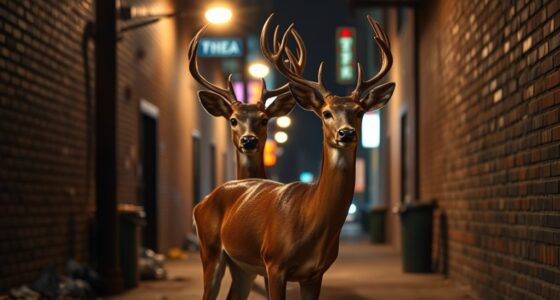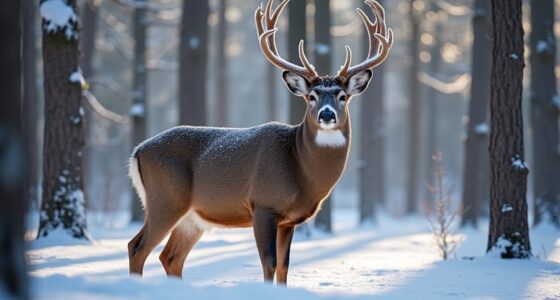You may wonder why deer shed their antlers every year. This process happens because of hormonal changes, mainly a drop in testosterone after the breeding season, which weakens the connection between the antler and skull. Shedding allows deer to conserve energy during winter and makes room for new, healthier antlers that help them compete for mates and defend territory. If you want to understand how this cycle works in detail, there’s much more to discover.
Key Takeaways
- Deer shed their antlers annually to conserve energy when they are no longer needed for mating displays or fights.
- Declining testosterone levels after the breeding season weaken the connection between antlers and the skull, causing shedding.
- Shedding allows deer to avoid injury and reduce discomfort from heavy, cumbersome antlers in dense habitats.
- The cycle enables the growth of new, larger, and healthier antlers for improved dominance and mate attraction each year.
- Environmental cues like daylight and temperature regulate hormonal changes that trigger both shedding and new antler growth.

Have you ever wondered why deer shed their antlers each year? It’s a fascinating process that ties into how these animals grow and renew their impressive headgear. Each year, deer undergo a cycle of antler growth, development, and shedding, which is essential for their survival and reproductive success. During the antler growth phase, which typically begins in the spring, the deer’s body produces a rich supply of blood and nutrients to fuel the rapid development of these bony structures. This growth is stimulated by increased levels of testosterone, which rise as the days lengthen, signaling the start of the breeding season. The antlers start as soft, cartilage-like structures, and over the months, they harden and become covered in a velvety skin that supplies blood and nutrients, aiding in their growth. This period of antler development is vital because larger, healthier antlers give male deer an advantage in fights for mates, displaying strength and dominance. The antler growth cycle is closely regulated by hormonal and environmental factors, ensuring timely development and shedding. Additionally, nutrient availability plays a crucial role in supporting optimal antler growth, highlighting the importance of a healthy diet for deer. However, once the breeding season ends and days grow shorter, testosterone levels decline. This hormonal shift triggers the shedding process, prompting the deer to shed their antlers. The shedding process begins with the weakening of the connection between the antler and the skull, specifically at the pedicle, which is the bony protrusion on the deer’s skull where the antler attaches. As the connection weakens, the antler becomes loose and eventually falls off, often with a small crack or break. This process is natural and necessary, allowing the deer to conserve energy during the winter months when antlers are no longer needed for mating displays or fights. Shedding also helps prevent injury, as large antlers can become cumbersome or dangerous in dense forests or during movement. The hormonal changes driving this cycle are finely tuned by environmental factors, ensuring the process occurs at the optimal times each year. After shedding, the deer’s body starts preparing again for the next cycle of antler growth, beginning with the regeneration of the pedicles. The process is continuous, driven by hormonal changes that respond to environmental cues like daylight and temperature. This annual cycle guarantees that deer maintain healthy, functional antlers that serve their reproductive and social needs. So, next time you see a deer without antlers, remember it’s just part of a natural, cyclical process that keeps these animals thriving. The shedding process is a remarkable example of how nature adapts and renews itself, ensuring that each year, deer can continue to grow impressive antlers for the next breeding season.
Frequently Asked Questions
When Do Deer Typically Start Growing New Antlers Each Year?
You might wonder when deer start growing new antlers each year. Typically, they begin during late spring to early summer, around May or June, as part of their antler growth cycle. During this period, antler shedding has usually occurred, and new growth begins. The antler growth cycle continues through summer, with the antlers maturing by fall. Understanding this cycle helps explain the timing of antler shedding and growth in deer.
Do All Male Deer Shed Their Antlers at the Same Time?
Imagine the majestic dance of nature’s cycles—do all male deer shed their antlers at the same time? Not quite. Their antler shedding varies, guided by individual antler growth cycles and environmental cues. Some shed early, others later, creating a dynamic, unpredictable symphony of change. This variation reflects nature’s intricate timing, reminding us that even in unity, diversity thrives. You’ll see different shedding times across deer populations, making each encounter unique.
How Long Does It Take for a New Set of Antlers to Fully Grow?
You wonder how long it takes for a new set of antlers to fully grow. After shedding, the antler velvet covering develops quickly during the growth cycle, usually taking about three to four months. During this time, your deer’s antlers increase in size and strength. Once fully grown, the velvet dries and is shed, revealing the hardened antlers ready for the rut. The entire process is a remarkable example of nature’s growth cycle.
Can Environmental Factors Affect the Size of Antlers?
You might wonder if environmental factors affect antler size. The answer is yes. Nutrition impact plays a essential role—adequate food, minerals, and water help deer grow larger, healthier antlers. Genetic influence also matters; some deer are naturally predisposed to bigger antlers. By improving habitat quality and ensuring proper nutrition, you can positively influence antler development, showcasing how environment and genetics work together to shape these impressive displays.
Why Do Some Deer Keep Their Antlers Longer Than Others?
You might notice some deer keep their antlers longer than others due to differences in antler coloration and shedding patterns. Factors like age, genetics, and health influence how long antlers stay intact. Deer with darker, thicker antlers often shed later, while lighter, thinner ones shed sooner. Environmental conditions can also impact shedding, but individual variations primarily determine how long deer retain their antlers.
Conclusion
Now that you know why deer shed their antlers each year, you might wonder what happens next. Do they ever miss those impressive antlers? The shedding process is essential for their growth and health, allowing new, stronger antlers to develop. It’s a fascinating cycle of renewal and survival. So, next time you see a deer without antlers, remember, it’s all part of nature’s way of keeping them thriving. Isn’t that a remarkable adaptation?










